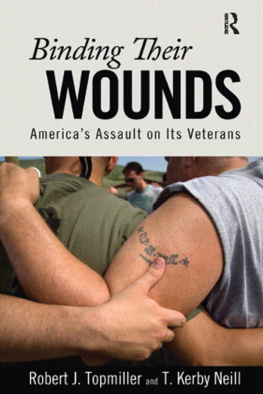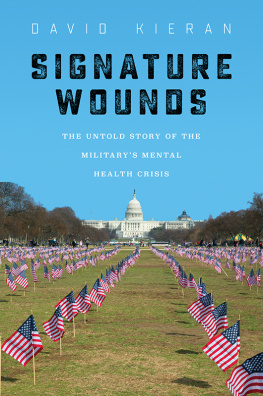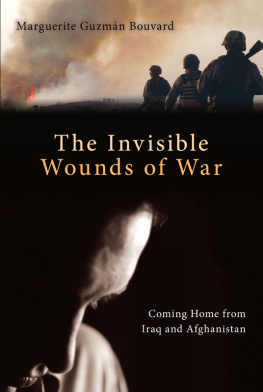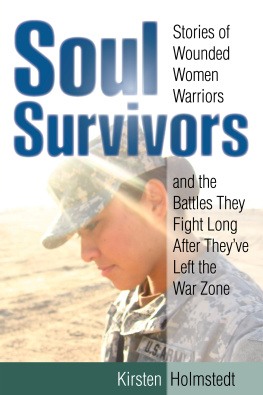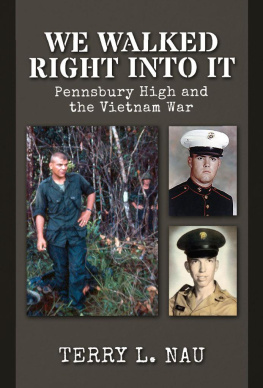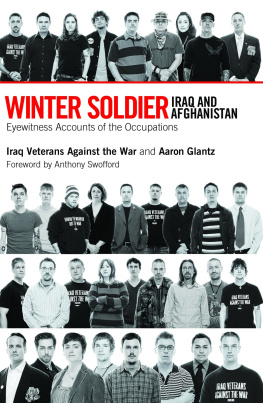BINDING THEIR WOUNDS
BINDING THEIR WOUNDS
Americas Assault on Its Veterans
Robert J. Topmiller and T. Kerby Neill
With a foreword by George C. Herring
First published 2011 by Paradigm Publishers
Published 2016 by Routledge
2 Park Square, Milton Park, Abingdon, Oxon OX14 4RN
711 Third Avenue, New York, NY 10017, USA
Routledge is an imprint of the Taylor & Francis Group, an informa business
Copyright 2011 ,Taylor & Francis.
All rights reserved. No part of this book may be reprinted or reproduced or utilised in any form or by any electronic, mechanical, or other means, now known or hereafter invented, including photocopying and recording, or in any information storage or retrieval system, without permission in writing from the publishers.
Notice:
Product or corporate names may be trademarks or registered trademarks, and are used only for identification and explanation without intent to infringe.
Library of Congress Cataloging-in-Publication Data
Topmiller, Robert J., 1948-2008
Binding their wounds : Americas assault on its veterans / Robert J. Topmiller and T. Kerby Neill; with a foreword by George C. Herring.
p. cm.
Includes bibliographical references and index.
ISBN 978-1-59451-571-2 (hardcover : alk. paper) ISBN 978-1-59451-572-9
(pbk. : alk. paper)
1. VeteransMedical careUnited StatesHistory. 2. Disabled veteransMedical careUnited StatesHistory. 3. United States. Dept. of Veterans AffairsHistory. I. Neill, T. Kerby. II. Title.
UB369.T67 2011
362.1086970973dc22
2011004298
ISBN 13 : 978-1-59451-571-2 (hbk)
ISBN 13 : 978-1-59451-572-9 (pbk)
Designed and Typeset by Straight Creek Bookmakers.
Contents
by George C. Herring
Chapter One
Help Me, Doc
Chapter Two
The VAs Story
Chapter Three
Atomic Veterans
Chapter Four
Agent Orange
By Peter Berres
Chapter Five
Gulf War Syndrome
Chapter Six
War and the Human Psyche of Americas Veterans
Chapter Seven
Veterans Suicides
Chapter Eight
The VA Today
Chapter Nine
Help Us, Doc, to Avoid the Next War
I FIRST MET BOB DOC TOPMILLER in August 1994. He had just arrived at the University of Kentucky for graduate school; I had just returned from a year as a visiting professor at West Point. He was part of a very talented group of new graduate students coming to UK from all over the country. I had seen his application materials when I was at West Point. I knew of his military service at the epic 1968 battle of Khe Sanh, where he was a medic and known as Doc. I was also aware of the excellent work he had done as an M.A. student at Central Washington University. I was especially impressed with his thesis on the Buddhist movement in South Vietnam, a phenomenon that was both crucial to the history of the Vietnam War and also, surprisingly, understudied. I was very excited at the prospect of working with him on his doctoral studies.
My anticipation was more than rewarded. As a student, Bob proved to be hard working and dedicated, a person who set high standards for himself and those he worked with. He quickly became the leader of his cohort of students. In seminars, he was an excellent presenter, a tough questioner of other student presenters, and a searching critic, always bringing a skeptical eye to the books he read. He helped to make the seminars of those years some of the best I ever taught. He proceeded smoothly and expeditiously toward the doctoral degree. Outside the classroom, he was an active runner and was legendary for his aggressiveness on the basketball court. During one of his summers in the doctoral program, he studied the Vietnamese language at the University of Wisconsin, an event, I believe, that changed his life in important ways.
For the dissertation, Bob expanded his work on the Buddhist movement in South Vietnam. He focused on the Buddhist-led revolt in northern South Vietnam in early 1966 that nearly brought the South Vietnamese government to its knees and thatmore than either of us had previously realizednearly produced in Washington a fundamental reassessment of the U.S. role in South Vietnam. New documentation he unearthed from the Lyndon Baines Johnson Presidential Library in Austin, Texas, made it very clear to us that, in the wake of the Buddhist upheaval and the Saigon governments resort to force to suppress it, some top U.S. officials came to doubt both the morality and the viability of the U.S. commitment to South Vietnam. Bobs dissertation was published in 2002 by the University Press of Kentucky under the title The Lotus Unleashed: The Buddhist Peace Movement in South Vietnam, 19641966. He also published an important article, Confrontation in Danang: III MAF and the Buddhist Struggle Movement in South Vietnam, 1966, detailing the crisis of early 1966 involving a conflict between the Buddhists and the South Vietnamese government and its U.S. backers in the volatile area around Da Nang.
Bob never attempted to compartmentalize his scholarship and his powerful emotions about the war. During his first trips back to Vietnam, he made contact with Buddhists. He studied their beliefs, and became more and more convinced that their movement had offered a peaceful alternative to the war that wracked Vietnam through the sixties and into the seventies. He saw Lyndon Johnson and especially his secretary of defense, Robert McNamara, as prolonging the bloodshed in Vietnam for such abstract reasons as their own and their nations credibility. On such subjects, he could become passionate, indeed outraged. I can vividly recall during the defense of his dissertation a spirited argument in which Bob, although outnumbered, held his ground on questions of scholarly objectivity against moral engagement, specifically, in this case, his firmly held contention that had the Buddhists been heeded in 1966 Vietnam might have been spared nine more years of war.
Docs deepening reengagement with Vietnam during and after he completed work on his dissertation eventually took its toll. His experience as a young medic at Khe Sanh, he later wrote in his compelling memoir Red Clay on My Boots, sparked a lifetime of profound alienation from the society around me. He may have sought by going back to Vietnam to exorcise the demons that still haunted him. Following completion of his degree, he returned as often as he could, in all fourteen times. He revisited Khe Sanh. But over time, his trips encompassed a much broader effort to learn more about the country and its people and thereby, perhaps, come to terms with the war. He traveled all over Vietnam and also into Laos and Cambodia. He talked to people in many walks of life. He discussed with monks in various pagodas in Ho Chi Minh City not only the events of 1966 about which he had written but also their own beliefs and especially their commitment to peace. He discovered much common ground with Vietnamese war veterans, from both the Army of the Republic of (South) Vietnam and the Peoples Army of (North) Vietnam. He also talked to hill people in the Central Highlands of Vietnam and in Laos. He listened to victims of the My Lai massacre of 1968 tell their horrific story. He especially connected with those Vietnamese children who were victims of Agent Orange, and he established close ties with a treatment center, the School of the Beloved, near Hue. He was outraged by the Vietnamese governments oppression of Buddhists and minority groups. He recalled that, at the end of his military service, he had hated the Vietnamese. But as a result of his travels and his conversations he developed greater understanding, empathy, and compassion. He grew in his appreciation of Vietnamese sacrifices during thirty years of war. Indeed, he claimed to have found more in common with the people of Vietnam than with many Americans. But he did not find peace of mind. Rather, he compared himself to Kien, the protagonist of Bao Ninhs powerful novel

